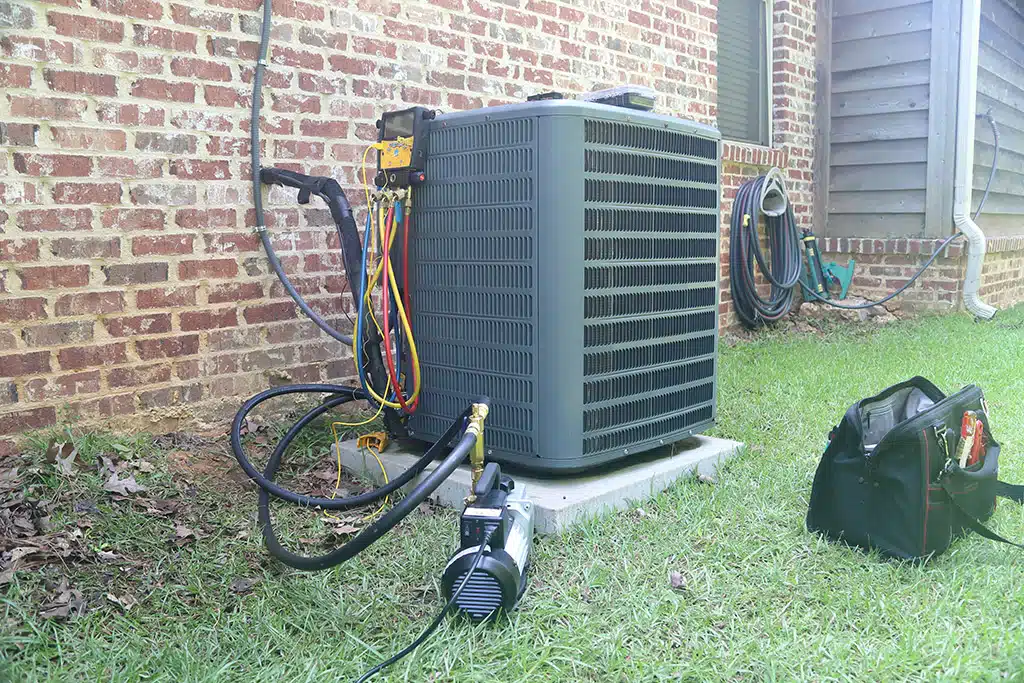As the seasons change, it’s critical to prepare your heat pump for the upcoming weather and ensure its optimal performance. Regular maintenance is essential to extending the life of your heat pump while maximizing its efficiency. By following a comprehensive furnace replacement, installation, and maintenance checklist, you can rest assured that your heat pump will be ready to face the new season and keep you comfortable.

101 Heat Pump Maintenance Checklist
Clean or Replace Air Filters
Air filters capture dust, pollen, and other airborne particles that can accumulate and hinder the airflow of your heat pump. A clogged filter can strain the system and reduce its efficiency. To avoid this, follow the manufacturer’s recommendation for cleaning or replacing the air filters. This can vary from every 30 days to every three months, depending on the type of filter and the level of pollutants in your home.
Check the Condensate Drain
The condensate drain removes the excess moisture produced due to the heat pump’s operation. Over time, this drain may get clogged with algae, dirt, or debris, resulting in water leaks or system damage. Inspect the condensate drain and clear any blockages. If needed, use a bleach solution to disinfect the drain and prevent future algae growth.
Test the Thermostat
Verify your thermostat is functioning correctly by setting it to heating and cooling modes. Monitor if the system responds as expected and reaches the set temperature. If there are any issues, such as inaccurate temperature readings or unresponsiveness, it may be a sign of a faulty thermostat. Consider replacing or recalibrating it for precise temperature control while reducing energy waste.
Clear the Outdoor Unit
Inspect the outdoor unit of your heat pump and remove any debris, such as dirt, leaves, and twigs, that may have accumulated over time. These obstacles can restrict the airflow and reduce the performance of your heat pump. Using a soft brush or a garden hose, gently clean the fins and remove any dirt or grime buildup.
Consider Upgrading to a Smart Thermostat
If you haven’t already, consider upgrading your old thermostat to a smart one. Smart thermostats offer advanced features such as remote temperature control, energy usage tracking, and learning capabilities. These features can help you optimize the performance of your heat pump, save energy, and lower your heating and cooling costs.
Schedule a Professional Maintenance Visit
While there are many furnace replacement, installation, and maintenance tasks that you can DIY, scheduling a professional heat pump repair and installation visit at least once a year is recommended. A skilled technician can thoroughly check, clean, and tune your heat pump system. They can identify potential issues and adjust to ensure peak performance and efficiency.
Inspect Electrical Connections
Before you examine the electrical connections of your heat pump, turn off the power supply. Check for loose or corroded wires and tighten any required connections. Call a technician for further heat pump inspection and repairs if you spot any wear or damage, such as exposed wires or frayed insulation.
Inspect Refrigerant Levels
Maintaining the proper refrigerant levels in your heat pump is critical for its optimal performance and efficiency. During the cooling mode, the refrigerant is responsible for absorbing heat from the indoor air and transferring it outside, while in the heating mode, it does the opposite. If the refrigerant level is too low, it can cause your heat pump to work harder, leading to massive energy consumption and decreased cooling or heating capacity. Inspecting the refrigerant levels should be done by a professional heating technician with the proper tools and expertise. They will check the pressure levels and ensure the refrigerant meets the manufacturer’s recommended specifications. If the levels are low, it may indicate a leak in the system, which should be addressed and repaired promptly to prevent further damage.
Monitor Energy Consumption
Keep track of your heat pump’s energy consumption to identify any sudden spikes or increases. Unusually high energy usage may indicate a problem with your heat pump system or a need for maintenance. Monitoring your energy consumption can help you identify potential issues beforehand and take appropriate action.
Stay Updated on Manufacturer’s Recommendations
Lastly, make it a habit to stay updated on the manufacturer’s recommendations regarding maintenance and care for your particular heat pump model. The manufacturer may provide additional guidelines or suggest specific tasks that need attention during different seasons. Following their recommendations ensures your heat pump operates at its best throughout the year.

Don’t Settle for Anything Less! Dial (636) 542-8600 for Stay Cool Climate Control – Your Expert in Furnace and Heat Pump Excellence!
When it comes to your furnace and heat pump needs, you need a team of dependable and experienced professionals. Look no further than Stay Cool Climate Control! With our years of expertise in the industry, we are dedicated to providing exceptional service and ensuring that your heating and cooling systems are in top-notch condition.
Whether you want to install a new furnace or heat pump or need repairs and maintenance for your existing system, our skilled professional can handle it all. We pride ourselves on delivering prompt, reliable, and efficient service, ensuring comfort and satisfaction.
Don’t let a malfunctioning furnace or heat pump disrupt your comfort during the new season. Trust the Stay Cool Climate Control experts to handle all your furnace and heat pump installation and repair needs. Experience the difference and give us a call today!
